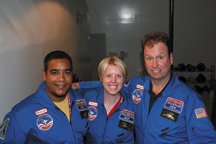The minute Jose Santiago walked through the doors of the Dunkin Donuts near the city line in Bayonne, people took notice.
He was wearing the blue uniform of a NASA astronaut that he had received as part of a recent trip to Honeywell Educators at Space Academy at the United States Space and Rocket Center in Huntsville, Ala.
The kids seated at the tables didn’t merely stare. They wanted to touch the uniform to see if it was real, as if by touching it, they made some connection to space.
Santiago, a Bayonne resident who teaches at Dickinson High School in Jersey City, was among nine math and science teachers from New Jersey and 220 teachers from 17 countries and 44 U.S. states who won a scholarship to what is sometimes known as “Space Camp,” where each underwent intensive astronaut training in June as guests of Honeywell.
“This is what happens,” said Karee Ethridge, a teacher at Washington Community School in Bayonne who also took the trip. “People get excited about space.”
“They want us to bring back our experiences to the classroom.” – Michael Urbanowicz
________
Applied last year
The teachers applied to be part of the program last November, and were accepted to take part in the trip to the U.S. Space and Rocket Center in Huntsville, Ala., from June 11 to 23.
“We had to write a 500-word essay and answer some open-ended questions about math and science demographics,” Ethridge said.
All three were surprised that they made the final cut.
“I never thought I would be one of the 220 out of the more than 3,000 teachers that apply every year,” Ethridge said.
Created in partnership with the U.S. Space and Rocket Center in 2004, the Honeywell Educators at Space Academy program is designed to help teachers move beyond the standard math and science curriculum, with supplemental teaching techniques developed through real-life astronaut training.
Since its inception, the program has trained more than 1,100 science and math teachers with the aim of having them become more engaging and inspiring educators, and these three came back very inspired.
Urbanowicz said the idea was to incorporate space technology into the classroom.
“They want us to bring back our experiences to the classroom,” he said.
Ethridge, who is responsible for technology in her school, said she did not really have a taste for space, but the experience gave her one. Going through simulators and other training astronauts face, she learned to appreciate that area of science, and became filled with energy and the need to bring that experience back to her students.
She said Honeywell provides a lot of materials for her to use.
Santiago said the idea is to incorporate space themes into their lessons on earth science back home, something he is particularly interested in. But before the class, he had to incorporate these themes for himself, because no materials were available.
“I was flying by the seat of my pants,” he said.
Santiago admitted that he once had a dream of working for NASA, and applied for the trip after he had heard another teacher talking about it.
Grueling hours
The hours were grueling. They started at 7 a.m. and didn’t finish until 9 p.m.. Teachers attended workshops, seminars, and training exercises. In some cases, they learned math that required them to calculate information for a different planet, such as a project associated with the landing and operations of a Martian lander, using an egg as a passenger. The idea was to make the proper landing without breaking the egg.
Each teacher got to act out the role of a member of a space team, often getting some significant problem thrown at them that they must solve together.
Lectures and seminars sometimes let them meet former astronauts and other key figures in NASA’s long history. People tried to convey the awe of space and the need for the next generation to begin to take its place in these fields. Many of the people in the industry are getting older, and the need for new engineers and others is massive if work in space is to continue.
“There is a general apathy about science,” Santiago said.
Santiago said working with other teachers from around the country and the world was also enlightening. Ethridge said the trip allowed her to make contacts, creating a network of teachers she will keep in contact with, a valuable resource for expanding experiences.
Honeywell Educators participated in 45 hours of professional development with the teachers. Each teacher underwent real-life astronaut training, including a high-performance jet simulation, scenario-based space missions, land and water survival training, and flight dynamics programs.
Each Honeywell Educator received a full scholarship following a rigorous application and selection process. Scholarships included tuition for the six-day program, roundtrip airfare, meals, accommodations, and program materials.
Al Sullivan may be reached at asullivan@hudsonreporter.com.
